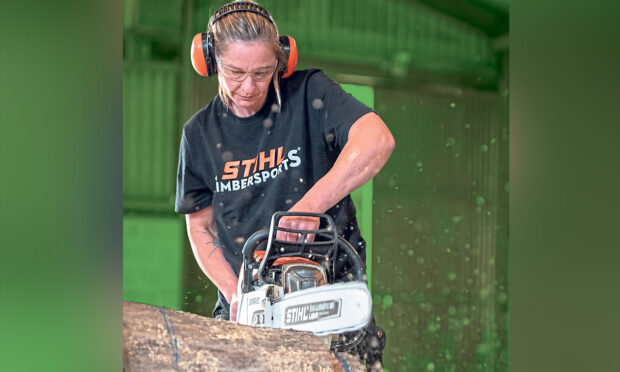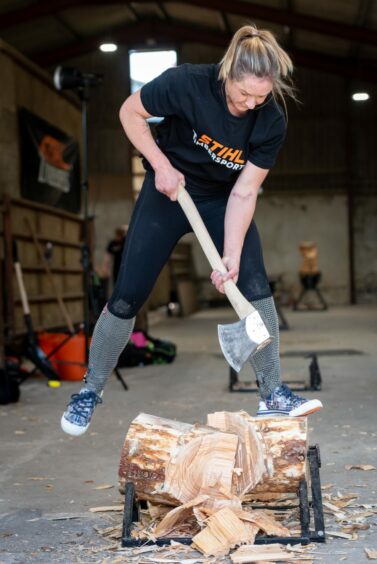
Standing astride a huge section of tree trunk, a seven-pound axe raised above her head, Catherine Eccles tenses her muscles and then throws every ounce of strength into a powerful downward swing that hews the wood towards its core with a satisfying crack.
The arborist isn’t just splitting wood in her garden to heat her home this year, although that is a useful bonus of training for an extreme sport inspired by lumberjack skills that she hopes to see take root in Scotland.
Timbersports, or competitive wood chopping, sees lumberjacks and lumberjills from around the world compete to saw, chop and slice through tree trunks at speed, using different axes, saws and chainsaws across a range of disciplines that mirror how lumberjacks, or loggers, fell trees.
Stihl Timbersports is the worldwide league of lumberjack sports, which started 37 years ago in the USA and arrived in Britain in 2012 with the country’s first British Championship.
Eccles is one of two Scottish loggers hoping to carve out a legacy of timbersports in Scotland and is the first Scottish woman to take part in lumberjack sports competitively.
At home, she can practise the underhand chop, where competitors chop through a 32cm-thick tree trunk with an axe from above on both sides within 90 seconds.
“It’s really tough,” said Eccles, 42. “Ninety seconds doesn’t seem long but when you are swinging the axe and hitting hard into the wood, the lactic acid kicks in and you feel the fatigue in your muscles, especially the arms, really quickly.
“When I first started training I was using muscles I never knew I had!”
The mum-of-two discovered timbersports through her work as a tree surgeon but it was attending the 2018 World Championships in Liverpool that inspired her to get involved herself. “I applied for a taster day and ended up being invited to a training camp down in Wales,” added Eccles.
“I went through the training programme, which involved four training camps in the lead-up to the first-ever British women’s timbersports championships in Malvern last June.”
While she spends her days climbing, trimming and dismantling trees, Eccles sets aside one night a week to practise wood chopping with an axe in her back garden, using spare wood she’s collected from work. She then seasons and processes her chopped logs for firewood.
“The physical side of my job has helped me in terms of fitness, and I’m used to using a chainsaw, so I can practise for the stock saw event at work. But learning how to chop with an axe and buck saw has been a learning curve,” said Eccles, from Coylton in Ayr, who has worked as a tree surgeon for over two decades.
Yet it’s not all about brute strength, she said: “There’s a technique to it. You need to stick to your lines and hit the wood in the right place, trying to avoid any knots. When you know you’ve done your cuts right and cut through the block it’s massively satisfying.
“I’ve chopped wood my whole life but I love the athletic side of timbersports and the community, it’s such a friendly sport. I’ve made good friends through it.”
With origins in 19th-Century Australia, where foresters would compete with each other outside work to see who had the best tree-felling skills, it has become a high-octane sport that requires strength, stamina, power and precision. In the competitions sponsored by chainsaw makers Stihl, women compete in three disciples: the underhand chop, stock saw and single buck, while the men compete in a further three events including the standing block chop, springboard and chop saw.
To avoid injuries, competitors wear protective gear, including ear protectors, safety glasses, safety boots and chainmail socks and trousers.
Eccles was one of eight women to compete in the first British Women’s Timbersports Championship finals in June. “It was an incredible thing to be part of,” she said. “All the women I went through training with are so supportive and encouraging to help you progress. I was disappointed in how I did at the finals but I went on to get a third place in the underhand chop at a smaller competition in Wales. That gave me confidence so, with more training, I hope to one day compete with the best in Europe.”
‘It is quite dangerous. You could shave with the axes’
Catherine Eccles has received support from fellow Scot Graham Turner.
The 36-year-old from Penicuik is the British No 2 and will this week compete in the Stihl Timbersports World Championship in Gothenburg in Sweden.
Turner is the first Scot to take part in official competitions, starting in 2019, and the first to podium when he came second in last year’s British final behind Welshman Glen Penlington.
He said: “The world championships are going to be phenomenal. The atmosphere at any of the big finals is incredible and I remember adrenaline rushing through me. I love the thrill and exhilaration of it. Coming second at the British finals, and as the first-ever Scottish timbersports athlete, was a massive achievement for me. I was incredibly proud to fly the saltire on the podium.”
Turner has set up his own club, Alba Axemen, to encourage more Scots to get involved. “Obviously it’s quite a dangerous sport because the axes are extremely sharp, you could have a shave with them,” said Turner, a former rugby player who runs a fencing company in Penicuik.
“That’s how we test our axes, by running them up our arms. I always have bald patches at competitions. Not all the equipment is readily available so it’s not something you can jump into straight away but that’s why I’ve started the club.” Stihl Timbersport’s Vicky Tween has seen interest in the sport grow, especially on the women’s side following the British Women’s Championship.
She said: “With eight homegrown athletes, Britain in its first year already has more women competitors than any other country in Europe.”

Enjoy the convenience of having The Sunday Post delivered as a digital ePaper straight to your smartphone, tablet or computer.
Subscribe for only £5.49 a month and enjoy all the benefits of the printed paper as a digital replica.
Subscribe